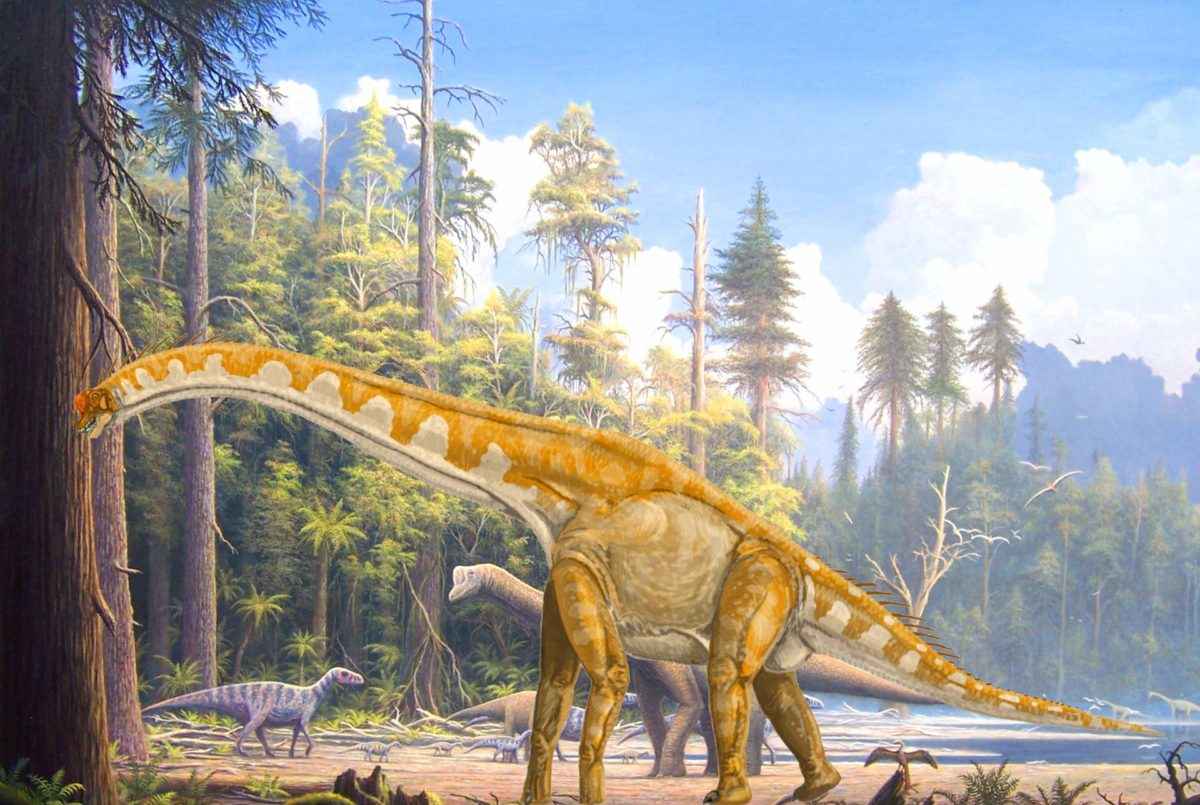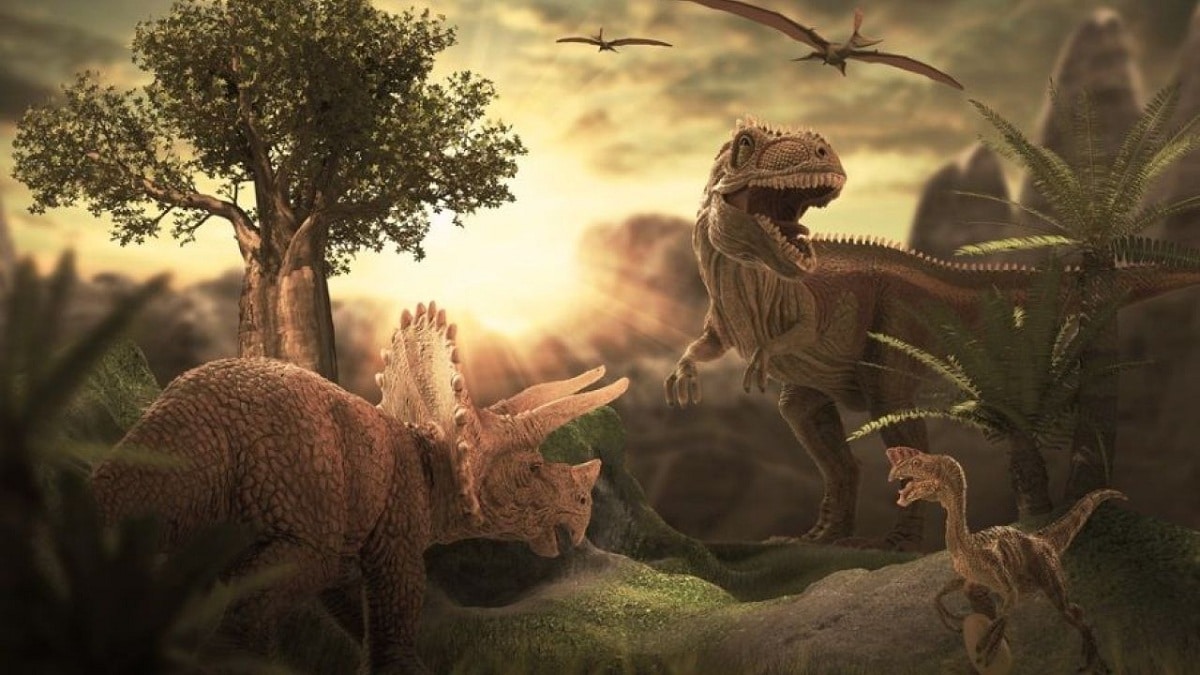
As we know within the era of Mesozoic There are 3 periods that mark differences in the development of both flora and fauna and climate and geology. Those 3 periods are: Triassic, Jurassic y Cretaceous. Today we are going to focus on studying the Jurassic fauna. This is the period when all dinosaurs spread through most of the tropical areas of the planet.
In this article we are going to tell you everything you need to know about the development of the Jurassic fauna.
Key features

If the Jurassic period stood out for something, it is that a great development of life was consolidated in a broad way both at the level of plants and animals. And it is that in the 56 million years that this period lasts, all plants could create jungles and forests in which a large number of animals proliferated.
Among these animals that make up the fauna we find dinosaurs. The animals that predominated in all landscapes were both terrestrial and aquatic environments. We must not forget that during this period at the geological level there was an intense activity of the tectonic plates.
Dinosaurs were the best known animals thanks to the fact that they have been studied in great depth with the fossils that have been recovered. Animal life during this period was able to conquer all habitats both terrestrial, marine and aerial.
Development of the Jurassic fauna

invertebrates
Within the group of invertebrates we can see that mollusks predominated. Within the mollusks, it was especially the gastropods, bivalves and cephalopods that were most expanded and diversified. Due to an extinction that occurred during the late Triassic some classes such as the Ammonoids, Nautiloids (persist to this day) and Belemnoideos.
Another group of invertebrates that also experienced great diversification during the Jurassic were the echinoderms. Within the echinoderms, those belonging to the class of asteroids were the ones that spread the most. In this class we have starfish. Echinoids populated a large number of marine habitats. Within this group are sea urchins.
Throughout the period arthropods abounded. Mainly all those belonging to the class of crustaceans were developed in the marine environment, in which we have crabs. In addition, there were some specimens of insects such as butterflies, wasps and grasshoppers.
Vertebrates

As is to be expected within the vertebrates, those who completely dominated this period were the reptiles. And it is that of the fauna of the Jurassic the group of animals that predominated the most were the dinosaurs. Amphibians also began to stand out but to a lesser extent. Although there were few representatives of the group of mammals, they also began to develop in this period.
In aquatic habitats we find ecosystems teeming with life. Most of the life that existed at that time was developed in the marine environment. There was a great variety of fish, although aquatic reptiles were the kings of the water. The most representative are the following:
- Ichthyosaurs: this species of reptile was distributed by all the seas of the world. Its diet was fully carnivorous and it attacked large prey. They could measure up to 18 meters in length and had several fins, a tail and a dorsal. It is its morphology we find an elongated body and a long snout that served to better capture the prey. It had very developed environments to be able to make good tears. According to the fossils that have been found of the ichthyosaurs we can deduce that they were viviparous animals. That is, the embryo develops within the mother's body.
- Plesiosaurs: these marine animals were larger than the ichthyosaurs. They were capable of measuring up to 23 meters in length. Its neck had an extremely long morphology. They had 4 limbs that served to move faster underwater and were shaped like fins. His body was quite wide.
Jurassic fauna of the aerial and terrestrial type

Let's not forget that during the Jurassic period small birds also appeared, although flying reptiles were the masters of the air. These were the Pterosaurs. These animals had different sizes depending on the species and we could find from small to some of a huge size. Its body was covered by hairs and extensive wings that were formed by a membrane that hooked one one to the fingers of the hand in a similar way to bats.
Thanks to the numerous fossils that we found of the Pterosaurs we can know that they were oviparous. It has been possible to deduce that they had a good view to be able to capture prey from the heights. This is because their diet was fully carnivorous and they could also feed on fish and some insects. In order to catch fish that are in the water they need a good view.
As the vertebrates of the terrestrial habitat we have mainly the large dinosaurs. Dinosaurs existed of two types: carnivores and herbivores. Among the herbivores, the apatosaurus, the brachiosaurus, the gigantspinosaurus and the camera were predominant, among others. We will briefly describe them:
- Apatosaurus: It can weigh up to 30 tons and was large (21 meters).
- Brachiosaurus: It walked on 4 legs and was characterized by its large size and long neck. It was 13 meters high and 23 meters long.
- Camarasaurus: it could measure up to 18 meters in length. It had its vertebrae of the spine with a kind of air chamber that served to reduce its body weight.
- Gigantspinosaurus: it was completely armored with bone plates. Although it wasn't that big, it had great protection. It could measure up to 5 meters in length.
Among the carnivorous dinosaurs we have the following:
- Allosaurus: on their extremities they had sufficiently developed claws to be able to capture their prey. They could measure up to 12 meters in length.
- compsognathusAlthough it was a carnivore, it was extremely small in size. It only reached a meter in length.
- Cryolophosaurus: it was only 6 meters long and 3 meters high. From its front limbs it had strong claws capable of destroying its prey.
I hope that with this information you can learn more about the fauna of the Jurassic.